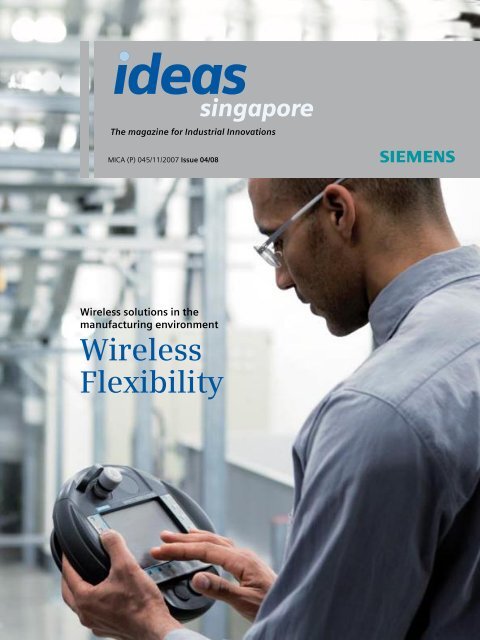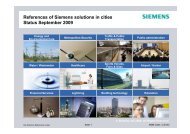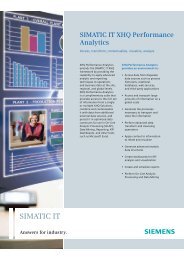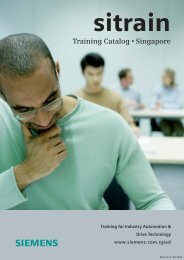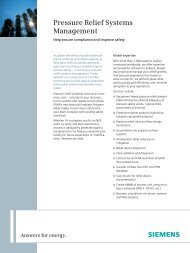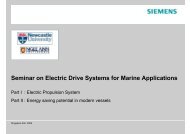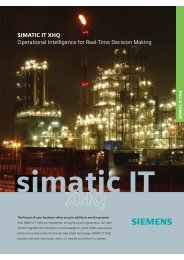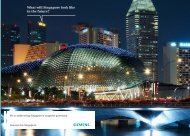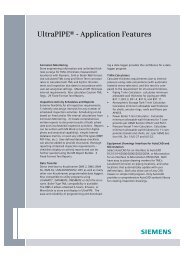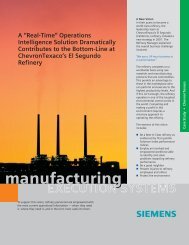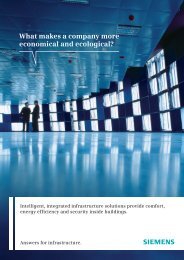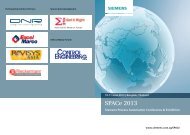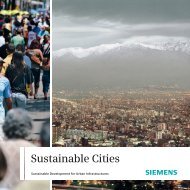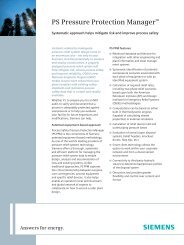Wireless Flexibility - Siemens
Wireless Flexibility - Siemens
Wireless Flexibility - Siemens
You also want an ePaper? Increase the reach of your titles
YUMPU automatically turns print PDFs into web optimized ePapers that Google loves.
ideas<br />
singapore<br />
The magazine for Industrial Innovations<br />
MICA (P) 045/11/2007 Issue 04/08<br />
<strong>Wireless</strong> solutions in the<br />
manufacturing environment<br />
<strong>Wireless</strong><br />
<strong>Flexibility</strong>
C o n t e n t s<br />
i d e a s s i n g a p o r e | 0 4 - 0 8<br />
<strong>Siemens</strong> AG<br />
<strong>Siemens</strong> AG<br />
<strong>Siemens</strong> AG<br />
Page 4<br />
WIFI promotes <strong>Wireless</strong> LAN<br />
standards with the aim of improving<br />
the interoperability of wireless local<br />
area network products.<br />
Page 10<br />
The fast growing photovoltaic<br />
market offers opportunities for<br />
sili-con producers and their<br />
suppliers.<br />
Page 18<br />
The Simatic Mobile Panel 277F IWLAN, is<br />
the first wireless HMI device with safety<br />
and has two enabling buttons and an<br />
emergency stop button.<br />
p Cover<br />
<strong>Wireless</strong><br />
04 <strong>Wireless</strong> <strong>Flexibility</strong><br />
<strong>Wireless</strong> solutions in the<br />
manufacturing industry<br />
p Industry<br />
Bioethanol<br />
08 Clever Alternative<br />
Bioethanol as a replacement for<br />
conventional fuel<br />
Photovoltaic<br />
10 The Power of the Sun<br />
The Photovoltaic (PV) Value Chain<br />
Pharma<br />
11 Compliance Made Easy<br />
Pharmaceutical Industry<br />
p Products<br />
Simocode<br />
12 Promoting Energy Efficiency<br />
Simocode intelligent motor<br />
management system<br />
Robicon<br />
14 Perfect Harmony<br />
The right medium-voltage AC drives<br />
for every application<br />
Mobile Panel<br />
18 HMI goes <strong>Wireless</strong><br />
First wireless machine control unit<br />
with safety functions<br />
TeleService<br />
19 Covering the Distance<br />
Simatic TeleService: Remote<br />
maintenance via modem<br />
p Training<br />
Sitrain<br />
16 Best in Class<br />
Sitrain - Training for Automation &<br />
Industrial Solutions<br />
p Technology<br />
Gas Emission monitoring<br />
20 Unique and Adapted<br />
Solution for the gas emission<br />
monitoring<br />
SIMATIC – 50 years<br />
22 Automation conquers the World<br />
Simatic- 50 years of proven<br />
engineering leadership<br />
23 In Brief<br />
ideas singapore | 2008
E d i t o r i a l<br />
“Innovation is the ability to see change as an opportunity –<br />
not a threat.“<br />
Driven by our scientific curiosity and commitment, we are<br />
constantly striving to inspire innovation – in our employees,<br />
our partners, and our customers.<br />
Dear Readers,<br />
In an increasingly global market, the industry calls for an<br />
efficient strategic production planning, higher production<br />
output at the minimal costs, and higher technical competencies –<br />
reliable and innovative partners who will support them with<br />
expertise and technology to achieve their aims.<br />
We at <strong>Siemens</strong> are proud to be one of these partners. Being the<br />
market leader in the field of industrial automation solutions, we<br />
are ready to give you the answer.<br />
In this issue, we will focus on products, which we believe that<br />
will help you achieve your objectives. We will discuss the latest<br />
on industrial applications and technologies such as wireless<br />
communication capabilities and energy efficiencies. Also allow<br />
us to celebrate the latest events and achievements we received on<br />
our decades of existence in Singapore – celebrating 100 years of<br />
<strong>Siemens</strong> in Singapore, 50 years of SIMATIC and strong PLC and<br />
software market leadership within Southeast Asia.<br />
We look forward to another 100 years with you and we will keep<br />
the anticipation of challenging ourselves to stay on being a true<br />
leader for the benefit of our customers in the industry here and<br />
overseas!<br />
The Editors<br />
ideas singapore | 2008
C o v e r<br />
W i r e l e s s<br />
p<br />
<strong>Wireless</strong> solutions in the manufacturing industry<br />
<strong>Wireless</strong><br />
<strong>Flexibility</strong><br />
WIFI promotes <strong>Wireless</strong> LAN standards with<br />
the aim of improving the interoperability of<br />
wireless local area network products based on<br />
the IEEE 802.11 standards and enhancing the<br />
user experience for wireless solution.<br />
Publicis<br />
ideas singapore | 2008
<strong>Wireless</strong> devices have become a part of everyday<br />
life and mobility is one the buzzwords<br />
of today. With the advent of WIFI<br />
into the computing world, being available anywhere<br />
and anytime has become almost given.<br />
Particular concern for many end users is the security<br />
and availability of such wireless system. Many<br />
may still harbor doubts about this technology, despite<br />
its benefits for better flexibility and lower costs as<br />
compared to a hardwired connection. All of this in<br />
view of the fact that methods for secure encryption<br />
and protection of industrial wireless communication<br />
had been available for several years.<br />
This article will discuss these issues and present<br />
valuable solutions arriving from the Scalance product<br />
line. It will also attempt to answer the solutions<br />
for IWLAN using the Scalance technology, which supports<br />
highly effective encryption mechanisms and<br />
intelligent radio field planning that will help ensure<br />
full data security.<br />
Security with Industrial <strong>Wireless</strong> Network<br />
The subject of data security when using WLAN was a<br />
particularly a hot topic at the time wireless data<br />
transfer was first introduced to industrial environments.<br />
Until 2002, no data encryption standards existed<br />
within IEEE 802.11, which defines wireless Ethernet<br />
communication.<br />
The 802.11i standard was developed to address<br />
this situation; it specifies the security mechanisms<br />
for <strong>Wireless</strong> LAN (WLAN) - encryption, identification<br />
and authorization. IEEE 802.11i is an amendment to<br />
the IEEE 802.11 standard specifying security mechanisms<br />
for wireless networks. The amendment has<br />
been incorporated into the published IEEE 802.11-<br />
2007 standards. They are commonly used today in<br />
their 802.11a, 802.11b, and 802.11g versions to provide<br />
wireless connectivity.<br />
With Industrial <strong>Wireless</strong> LAN (IWLAN), new IEEE<br />
802.11i mechanisms are available that are exactly<br />
the same as those for office networks. The security<br />
concept is made up of different mechanisms, such as<br />
encryption by means of temporary keys or the Advanced<br />
Encryption Standard (AES) – a highly secure<br />
encryption mechanism.<br />
Scalance W components represent a complete spectrum<br />
for the implementation of IWLAN networks and<br />
conform to the security standards defined in IEEE<br />
802.11i.<br />
Secured and Reliable Access Points<br />
Another interesting topic to discuss is the key piece<br />
of hardware for IWLAN which is the Access Point (AP)<br />
modules. These have to be design for industrial environments<br />
and performance. The access points are<br />
used for setting up radio networks in accordance<br />
with IEEE 802.11a/b/g/h up to 54 Mbit/s both at 2.4<br />
GHz and at 5 GHz in harsh industrial environments.<br />
Existing LAN and WLAN networks can easily be ex-<br />
A p p l i c a t i o n s o f W i r e l e s s T e c h n o l o g y<br />
In the manufacturing environments, acceptance of the wireless technology<br />
is growing in various applications such as:<br />
3<br />
3<br />
3<br />
3<br />
3<br />
3<br />
Automated guided vehicles and overhead monorails<br />
prevention of wear and high flexibility in the choice of route due to<br />
wireless transmission of data to the vehicles<br />
Cranes high flexibility through access to data communication with the<br />
moving unit independent of the location<br />
Mobile control desks<br />
reliable intervention in the process due to data communication over<br />
IWLAN with mobile units; the number of operator panels is therefore<br />
determined by the number of personnel and no longer by the number<br />
of control points<br />
<strong>Wireless</strong> access to field devices for configuration and testing without<br />
the need for prolonged modifications in the control cabinet<br />
Online access to service and maintenance drawings<br />
Immediate updating of the measures performed in the system over<br />
IWLAN; Optimized processes and reduced error ratios due to online<br />
information regardless of the location of the machine<br />
Communication with moving stations (e.g. mobile controls and<br />
devices), container logistics, storage and retrieval machines, conveyor<br />
systems, conveyor belts, rotating machines, trucks<br />
100<br />
10<br />
1<br />
0.1<br />
0.01<br />
Transmission rate Mbits<br />
HART<br />
IEEE 802.154<br />
<strong>Wireless</strong><br />
IEEE 802.11n<br />
IEEE 802.11g,a<br />
IEEE 802.11b<br />
IWLAN<br />
Bluetooth<br />
<strong>Wireless</strong> modem 4,33,868,915 MHz (U.S. only)<br />
Personal Area (PAN) 10m Local Area (LAN) 100m Wide Area (WAN)<br />
panded through these Scalance W-780 access points<br />
to include Industrial <strong>Wireless</strong> LAN.<br />
The AP that deployed in manufacturing plants need<br />
to withstand the operating conditions such as high<br />
temperature, ability to manage redundant power<br />
source, diagnostics alarm output, easy and quick replacement<br />
of faulty devices, and environments with<br />
steel structures.<br />
EDGE<br />
GPRS<br />
GSM<br />
Range, mobility<br />
Transmission rates and range of wireless protocols<br />
ideas singapore | 2008
C o v e r<br />
W i r e l e s s<br />
With its compact,<br />
space saving design,<br />
the Scalance W-784<br />
line of access points<br />
for industrial wireless<br />
LANs (IWLAN)<br />
specifically targeted<br />
at indoor radio<br />
networks and can be<br />
installed in a control<br />
cabinet or directly in<br />
a machine.<br />
Pictures: <strong>Siemens</strong> AG<br />
W i r e l e s s c o m m u n i c a t i o n s t a n d a r d s<br />
IEEE 802.11 is a set of standards for wireless local area network (WLAN) computer<br />
communication, developed by the IEEE LAN/MAN Standards Committee (IEEE 802) in<br />
the 5 GHz and 2.4 GHz public spectrum bands.<br />
Protocol<br />
Release<br />
Date<br />
The Scalance W-780 is the perfect solution for practically<br />
any access point requirement. The access points<br />
of the Scalance W-780 product line are optimized for<br />
the configuration of Industrial <strong>Wireless</strong> LAN (IWLAN)<br />
wireless networks for 2.4 GHz or 5 GHz with data transmission<br />
rates up to 54 Mbit/s. They can be used in all<br />
applications that require a high degree of operational<br />
reliability especially under extremely harsh environmental<br />
conditions.<br />
Suitable AP is available for specific applications,<br />
such as Scalance W-786 for demanding climatic requirements,<br />
Scalance W-784 for installation in a cabinet<br />
or integration in devices, and Scalance W-788 for<br />
cabinet-free assembly.<br />
Op.<br />
Frequency<br />
Data Rate<br />
(Max)<br />
Range<br />
(Radius Indoor)<br />
Depends, # and<br />
type of walls<br />
Range<br />
(Radius Outdoor)<br />
Loss includes one<br />
wall<br />
802.11a 1999 5 GHz 54 Mbit/s ~35 Meters ~120 Meters<br />
802.11b 1999 2.4 GHz 11 Mbit/s ~38 Meters ~140 Meters<br />
802.11g 2003 2.4 GHz 54 Mbit/s ~38 Meters ~140 Meters<br />
Different wireless technologies based on different requirements<br />
The devices were designed to be rugged, with impact-resistant<br />
housing, protected from water and dust<br />
(IP65), with high-resistance to shock, vibration and<br />
electromagnetic fields.<br />
Due to the high degree of protection (IP65) and the<br />
extended temperature range from -40°C to +70°C, the<br />
access points are ideally suited for use in the food and<br />
beverages industry (e.g. cooling technology) and in<br />
logistics. Scalance W products are silicone-free and<br />
can therefore be used in paint shops.<br />
Scalance W conforms to IEEE 802.11 standards, with<br />
additional functional expansions especially for applications<br />
demanding high reliability. It offers protection<br />
from unauthorized access, espionage, listening<br />
in and corruption of data due to effective<br />
encryption mechanisms.<br />
Several operating modes are available<br />
in one device: Set up of wide area wireless<br />
networks (infrastructure) with range<br />
up to 30 m indoors and approx. 100 m<br />
outdoors; point-to-point connection of<br />
Industrial Ethernet segments over large<br />
distances (several 100 m).<br />
The Scalance APs have quick commissioning<br />
capabilities with the swap medium<br />
PRESET-PLUG and quick device exchange<br />
in case of faults with the swap<br />
medium C-PLUG (Configuration Plug).<br />
Coordinated accessories with antennas,<br />
plugs, cables including RCoax cable<br />
(leaky wave cable) for a reliable radio<br />
link along the cable.<br />
ideas singapore | 2008
The Scalance W-786<br />
family of access points<br />
for industrial wireless<br />
LANs (IWLAN) is<br />
particularly suitable for<br />
installation in outdoor<br />
radio networks, for<br />
instance in public areas,<br />
mass transit systems,<br />
ports, offshore<br />
equipment, or container<br />
logistics<br />
Rugged Scalance W788 cabinet free<br />
assembly is needed in harsh industrial<br />
environments that are installed outside the<br />
control cabinets. IWLAN components from<br />
Simatic NET have been designed with IP65<br />
degree of protection and for operating<br />
temperatures between – 20 °C and + 60 °C<br />
with condensation and fulfill the strict<br />
Simatic requirements with respect to shock<br />
and vibrations. The connectors are<br />
vibration-proof and shakeproof. Sinema E<br />
(Simatic Network Manager Engineering) is a<br />
software tool for efficient planning,<br />
simulation and configuration of industrial<br />
WLAN applications in accordance with the<br />
802.11 a/b/g standards. It allows the design<br />
and simulation of entire IWLAN networks.<br />
The new software for industrial and office<br />
networks, including outdoor areas, is<br />
suitable for network engineers in the field<br />
and planning engineer<br />
Radio Field Planning Tool<br />
Prior to the installation of any wireless devices, detailed<br />
planning of the required radio field is an important<br />
element of the security concept. Using the<br />
right tools, the radio field can actually be designed so<br />
that reception is possible only where the receivers<br />
such as robots or transport systems are located. This<br />
will significantly deter attempts to tap communication<br />
without authorization from outside the permitted<br />
facility zone.<br />
With Scalance Sinema E software, <strong>Siemens</strong> provides<br />
a planning, simulation and configuration software for<br />
IWLAN applications that makes IWLAN networks visible.<br />
It displays field strengths, data rates, signal-tonoise<br />
ratios and overlaps between different radio<br />
fields, taking environmental aspects and device properties<br />
into account. With Sinema E, users gain a detailed<br />
overview of the radio field prior to start-up.<br />
Optimizations of the radio field zone can be easily<br />
and transparently carried out on the PC in a short<br />
amount of time. The software simulates and detects<br />
obstacles that could affect signal strength and uses<br />
simulation functions to calculate the required number<br />
and optimum installation points and parameters<br />
for the IWLAN devices.<br />
With the Security Wizard tool, <strong>Siemens</strong> assists users<br />
in setting the required security level and access<br />
rights. The tool guides users through a range of<br />
menus from which the relevant security features can<br />
be selected with a simple mouse click. This straightforward<br />
configuration not only saves time but also increases<br />
the user’s readiness to consistently apply the<br />
implemented security measures. Furthermore, uninvited<br />
guests are kept at bay.<br />
Manufacturing plants have various machinery and<br />
equipment that are tied together to perform specific<br />
task. These machines or equipment have automation<br />
system which needs to transact data. Communication<br />
over Ethernet have adopted and implemented successfully<br />
in manufacturing environment providing<br />
robust and stable communication platform.<br />
Conventional cabling method may be difficult to<br />
some areas due to constraints in accessibility, distance<br />
and temperature. Using Scalance technologies is an<br />
attractive option when cabling is extremely complex<br />
and time-consuming, or when a high degree of flexibility<br />
is called for, or even when the environment is<br />
highly contaminated. These can significantly reduce<br />
the effort required for maintenance. p<br />
Practical Security Configuration<br />
Data security should not be compromise. However, security<br />
measures often require a degree of expert<br />
knowledge from users.<br />
info<br />
contact<br />
www.siemens.com/simatic-net<br />
zavior.kuladasamy@siemens.com<br />
ideas singapore | 2008
I n d u s t r y<br />
B i o e t h a n o l<br />
p Bioethanol as a replacement for conventional fuel<br />
Clever Alternative<br />
<strong>Siemens</strong> offers a perfectly balanced portfolio that<br />
covers all areas of the ethanol industry based on Totally<br />
Integrated Automation.<br />
Growing energy demand and spiraling oil<br />
prices are putting financial strain on countries<br />
and causing increased demand for fossil<br />
fuel. Energy security has assumed greater significance<br />
than ever as energy consumption, food<br />
production and environmental quality are interconnected.<br />
As a result, many countries throughout the<br />
world see an attractive alternative in ethanol.<br />
A large number of measuring tasks have to be carried<br />
out in a manufacturing plant for bioethanol –<br />
starting with the receipt of raw materials and up to<br />
the delivery of the finished product. Selection of the<br />
correct instrumentation is very important for the efficiency<br />
of the complete plant. In addition to the technical<br />
specifications, the instruments must be safely<br />
integrated into the process automation. Reliability,<br />
long service life, and simple operation are also important.<br />
And in an emergency, a fast and trouble-free<br />
supply of spare parts must be guaranteed.<br />
Million liters) of ethanol. Corn is used as the primary<br />
feedstock. The project was realization from<br />
January 2003 to September 2003 with <strong>Siemens</strong><br />
China “SIAS”, Shanghai provided the project management<br />
services. The system was implemented<br />
by Vogelbusch as the contractor.<br />
The unique combination of TIA used throughout<br />
the plant includes the distributed control system<br />
Simatic PCS 7, a highly distributed 8000 I/O system<br />
with HART, PDM and optical network, eight redundant<br />
controllers, nine Operator Stations implemented with<br />
Chinese characters, and an MES based on OPC.<br />
<strong>Siemens</strong>, a partner for bioethanol<br />
<strong>Siemens</strong> has recognized the challenge and offers a<br />
perfectly balanced portfolio that covers all areas of the<br />
ethanol industry. Using Totally Integrated Automation<br />
(TIA) - all encompassing of a unique vast of products<br />
and systems portfolio, <strong>Siemens</strong> provides solutions for<br />
the complete ethanol process from receiving of raw<br />
materials to storage of the finished product.<br />
Jilin Fuel Ethanol plant in China<br />
Following a first boom in Brazil in the seventies, the<br />
tremendous increase in the price of petroleum and<br />
the recent demand for energy has finally turned ethanol<br />
into a global issue. In the USA alone, more than<br />
30 installations are being built every year and similar<br />
figures are being constructed in Brazil. In Europe, a<br />
traditional stronghold for biodiesel, planning is underway<br />
for a large number of ethanol plants. In Southeast<br />
Asia, the first installations have already commenced<br />
operations, including the largest plant in the<br />
world, located in Jilin, China.<br />
The largest ethanol plant in the world, Jilin Fuel<br />
Ethanol Co Ltd in China, was implemented with<br />
<strong>Siemens</strong> distributed control system PCS7. The current<br />
capacity is 200 Million gallon per year (750<br />
Optimizing the complete workflow with<br />
Totally Integrated Automation<br />
<strong>Siemens</strong> is the only single vendor that can provide a<br />
complete line of products and automation systems<br />
throughout an ethanol plant including all auxiliary<br />
systems. One set of engineering tools provides process<br />
automation from the field level to the control<br />
level through the enterprise management level including<br />
superior system diagnostics and asset management<br />
functionality. Reduced life cycle costs,<br />
shortened times to market and improved production<br />
efficiency can be easily achieved.<br />
Besides greater independence from fuel oil, which<br />
is becoming increasingly expensive, there are further<br />
arguments that speak clearly in favor of ethanol, namely<br />
reduction of greenhouse gases taking into consideration<br />
the entire CO2 cycle and reduction of toxic<br />
emissions when burning sulfur-free ethanol. Biofuels<br />
are also less toxic than conventional ones. p<br />
info<br />
contact<br />
www.siemens.com/biofuel<br />
adnan.rahman@siemens.com<br />
BED<br />
<strong>Siemens</strong> AG<br />
ideas singapore | 2008
Source: F. O. Lichts (2004)<br />
80,000<br />
70,000<br />
60,000<br />
50,000<br />
40,000<br />
Production 2005<br />
Asia<br />
9 %<br />
EU<br />
11 %<br />
Latin<br />
America<br />
42 %<br />
North<br />
America<br />
37 %<br />
Latin America<br />
North America<br />
EU<br />
Asia<br />
9.8 % / a<br />
Market Growth<br />
30,000<br />
20,000<br />
10,000<br />
0<br />
‘90 ‘91 ‘92 ‘93 ‘94 ‘95 ‘96 ‘97 ‘98 ‘99 ‘00 ‘01 ‘02 ‘03 ‘04 ‘05 ‘06 ‘07 ‘08 ‘09 ‘10 ‘11 ‘12<br />
Major growth / year (05–12):<br />
Peru (67.4 %), Columbia (21.4 %), EU (26.9 %), India (20.4 %), Brazil (6.5 %), USA (6.9 %)<br />
Bioethanol production from cornstarch and sugar is helping to fuel explosive growth in the worldwide market for<br />
green energy resources, topping 9.8 percent in Latin America, the US, Asia, and parts of Europe.<br />
G r e e n f u e l f r o m s t a r c h : t h e e t h a n o l p r o c e s s<br />
Starch e.g. Cassava<br />
Starch e.g. Corn<br />
Pretreatment<br />
Milling<br />
Mashing<br />
Water<br />
Enzymes<br />
Liquefaction,<br />
Saccharifaction<br />
Fermentation<br />
CO 2<br />
Distillation<br />
Decantation<br />
Thin<br />
Stillage<br />
Dehydration<br />
DGS<br />
Evaporation<br />
Gasoline<br />
Denaturizing<br />
Drying<br />
Syrup<br />
Fuel Ethanol<br />
DDGS<br />
DGS: Distillers Grains with Solubles<br />
DDGS: Distillers Dried Grains with Solubles<br />
ideas singapore | 2008
I n d u s t r y<br />
P h o t o v o l t a i c<br />
p The Photovoltaic (PV) Value Chain<br />
The Power<br />
of the Sun<br />
The fast growing photovoltaic<br />
market offers opportunities for silicon<br />
producers and their suppliers.<br />
vides value added opportunities for the manufactures<br />
and market sizes are growing at a very fast<br />
pace due to the rising oil price, environmental concerns<br />
and incentives given by some governments to<br />
adopt green energy.<br />
Solutions for the entire value chain<br />
Total value chain represents approximately Euro<br />
10 billion worth of market value in 2006 and projected<br />
figure of Euro 50 billion by 2010 as shown in<br />
Table 1.<br />
In view of the demands, many projects had been<br />
announced recently for various stages of productions<br />
such as Sitronics Samsung, Renewable Energy<br />
Corporation (REC) and NorSun in Singapore alone.<br />
<strong>Siemens</strong>: First in silicon<br />
info www.siemens.de/xxxxxx<br />
Poly silicon is the feedstock for photovoltaic The production process for Poly silicon was originally<br />
contact xxxxxx.xxxxx@siemens.com<br />
and microelectronics industry. However purity<br />
level of the silicon needed for photovol-<br />
“<strong>Siemens</strong> C process”. It has been refined over the<br />
established by <strong>Siemens</strong> in the 50s and it is still called<br />
taic is 7 to 8 N and for microelectronics is 9 to 11 N years for production performance by others and the<br />
(the N indicates the numbers of 9s behind the dot, method is widely used by leading manufacturers. p<br />
e.g. 8N means 99.99999999%).<br />
PV value chain consists of five major production info www.siemens.com/semiconductor<br />
stages as illustrated below starting from Poly silicon<br />
to solar modules. Each production stage<br />
contact woonfu.choo@siemens.com<br />
pro-<br />
Poly<br />
Silicon<br />
Mono Ingots<br />
Multi Ingots<br />
Wafers<br />
Solar Cells<br />
Solar<br />
Modules<br />
Current market size<br />
2006 (Billion Euro)<br />
Projected market size in<br />
2010 (Billion Euro)<br />
Growth rate<br />
market size<br />
Poly silicon 0.8 3.7 463%<br />
Ingots and wafers 1.6 6.8 425%<br />
Solar cells 3.1 13.3 429%<br />
Solar Modules 4.8 20.8 433%<br />
Total market size 10.3 44.6 433%<br />
info choo.woonfu@siemens.com<br />
Table 1: Market size and Projected Growth rate for each stage in year 2010<br />
BED<br />
10 ideas singapore | 2008
I n d u s t r y<br />
P h a r m a<br />
p Pharmaceutical Industry<br />
Compliance Made Easy<br />
Integrated solutions for production operations enhance quality<br />
and visibility and facilitate compliance with CFR Part 11.<br />
There is an increased awareness in the pharmaceutical<br />
industry to be more innovative in<br />
achieving operational efficiency. One such<br />
area is improving workflow and driving for paperless<br />
production operations or realistically speaking a less<br />
paper operation. By going electronic with production<br />
operations, we can improve the quality of the production<br />
records kept and therefore the overall documentation<br />
management and operational efficiency.<br />
Not forgetting that it also contributes to the green<br />
environment image. Moving in this direction shall<br />
require the automated computer systems to comply<br />
with FDA 21 CFR part 11, popularly referred to as<br />
part 11. Correspondingly, the validation process will<br />
also have to take part 11 into consideration. The automated<br />
system architecture can have a huge time<br />
impact on the validation process as a direct result of<br />
human activities involving documentation, procedural<br />
safeguards, checks, etc.<br />
No more automation islands<br />
To illustrate this, imagine a plant operated by “islands<br />
of automation” like the figure shown below (figure<br />
1) with handhelds and mobile programming<br />
devices, each with its own part 11 acceptable system<br />
from different vendors. Not only is this concept difficult<br />
for the part 11 compliance, it doesn’t offer a central<br />
user management, no central archiving and the<br />
effort for change will be high. The validation process<br />
would be quite a challenge.<br />
In contrast, the concept in figure 2 offers a central<br />
user management, central archiving, central engineering<br />
and central services for access control, audit<br />
trail, archiving, etc. By far, this would be an easier<br />
system to validate for part 11 compliance. p<br />
info<br />
contact<br />
www.siemens.com/ pharma<br />
eugene.yeo@siemens.com<br />
peraor<br />
aion<br />
peraor<br />
aion<br />
Figure 1 - Automation<br />
Islands: Standalone<br />
solutions without<br />
intercommunication<br />
ndsria erne<br />
ndsria erne<br />
rograing<br />
eie<br />
rograing<br />
eie<br />
ros<br />
00<br />
ros<br />
00<br />
anded irans irans ipar 2<br />
00<br />
anded irans irans ipar 2<br />
00<br />
ndsria erne<br />
peraor<br />
aion<br />
enra<br />
ngineering<br />
aion<br />
peraor<br />
aion<br />
Figure 2 - Integrated<br />
Architecture: Central<br />
User Management,<br />
archiving,<br />
engineering and<br />
overall audit trail<br />
ros<br />
00<br />
ros<br />
00<br />
irans irans ipar 2<br />
00<br />
irans irans ipar 2<br />
00<br />
02<br />
ideas singapore | 2008 11
RP ru ob dr ui k c t s U nSt ie mr ro uc bo rd i ek<br />
p Simocode intelligent motor management system<br />
Promoting<br />
Energy<br />
Efficiency<br />
With easy integration to PCS 7, the Simocode intelligent motor<br />
management system enables dynamic monitoring of motor performance<br />
and the opportunity to enhance energy efficiency in the plant.<br />
Energy consumption is the second largest operating<br />
expense in a process plant, after raw<br />
materials. And studies have shown that more<br />
than sixty percent of that energy is used to operate<br />
motors. Hence, optimizing motor energy consumption<br />
is a logical starting point in any energy cost reduction<br />
initiative.<br />
In the traditional process plant, it has not been economical<br />
to hardwire all of the operating data from<br />
individual motors back to the process controller,<br />
which makes it almost impossible to determine the<br />
energy consumption for different parts of the process.<br />
This information gap prevents plant operators<br />
M o t o r m a n a g e m e n t s y s t e m S i m o c o d e p r o<br />
Simocode pro (Sirius Motor Management and Control Devices) is the<br />
flexible, modular motor management system for constant speed motors.<br />
By means of a Profibus DP interface it can easily be linked to a higher-level<br />
automation system. Simocode pro implements all motor protection and<br />
control functions, provides operational, diagnostic and statistical data and<br />
organizes the communication between automation system and motor<br />
feeder. In addition, Simocode meets all the requirements for future-proof<br />
power management. Simocode pro is divided into two device series with<br />
different levels of functions:<br />
3 Simocode pro C (Compact): the compact motor management<br />
system for direct on-line starters and reversing starters<br />
3 Simocode pro V (Variable): the variable motor<br />
management system with an even greater range of functions<br />
including voltageand power monitoring<br />
The system also includes software tools for plant configuration,<br />
device parameterization, diagnostics and plant documentation.<br />
from scheduling partial shutdowns to improve energy<br />
efficiency or from taking advantage of the various<br />
incentives that electric utilities offer to balance<br />
demand.<br />
But today’s new class of DCS, exemplified by the<br />
<strong>Siemens</strong> PCS 7, not only provides regulatory control<br />
of processes, but can integrate high speed devices to<br />
enable dynamic monitoring of motor performance<br />
and, hence, much more sophisticated management<br />
of energy consumption.<br />
Simocode spells smart<br />
Simocode is an intelligent motor management system<br />
that can be added to the MCC motor bucket to<br />
make it “smart”. Hardwired circuitry running to the<br />
various motors across the plant is replaced with just<br />
one fieldbus cable and the compact tool provides a<br />
high level of protection, monitoring and control. For<br />
example, the control circuit can be “rewired” via a<br />
mouse click, and eliminating conventional relays saves<br />
space and reduces wiring expenditures.<br />
In particular, with Simocode, a high degree of detail<br />
on the status and performance of each motor component<br />
is provided, including motor current, direction,<br />
phase and overload status. This information can be<br />
sent up to the PCS 7 via a single Profibus DP cable.<br />
Having access to comprehensive data on motor activity<br />
in the process plant provides a number of benefits:<br />
Productivity improvement – engineers can modify<br />
operating parameters, analyze performance,<br />
and reset faults of an individual MCC bucket directly<br />
from the control room; downtime minimization – an<br />
unusual condition such as excessive current draw<br />
can be reported in the DCS, allowing operators to<br />
12 ideas singapore | 2008
T h e b e n e f i t s<br />
a t a g l a n c e<br />
<br />
■ Profibus DP<br />
■ Ethernet<br />
S<br />
S<br />
S-00<br />
DPPA Link<br />
3<br />
3<br />
3<br />
3<br />
3<br />
3<br />
3<br />
3<br />
Higher operating management<br />
and process quality<br />
Lower costs for planning,<br />
assembly and maintenance<br />
Multifunctional electronic full<br />
motor protection<br />
Detailed operating, service<br />
and diagnostic data<br />
Open communication via<br />
Profibus DP<br />
Safety disabling of drives<br />
thanks to emergency stop<br />
system monitoring<br />
Certified according to<br />
ATEX standards<br />
Compatible with previous<br />
Simocode-DP system<br />
ET 200M<br />
SIPAT D<br />
SIMOCODE<br />
■ Profibus PA<br />
take quick corrective action; energy management –<br />
power consumption of different parts of the plant<br />
can be collected within the DCS, allowing plants to<br />
create a strategy that optimizes both energy usage<br />
and production output.<br />
New and updated<br />
And now, the latest release of the Simocode pro motor<br />
management system features a number of new<br />
components, accessories, functions, plus an update<br />
of the parameterization software.<br />
The operator panel with display provides for indication<br />
of current measured values, diagnostic data and<br />
status information directly at the control cabinet. Selecting<br />
predefined profiles, the user can determine the<br />
values to display during normal operation. As for functions,<br />
two new logic blocks can do arithmetic operations<br />
and adjust, calculate and convert analog values<br />
such as temperature, allowing measured values to be<br />
transferred to the DCS in predefined units. An addition<br />
to the statistical data provided by Simocode is “motor<br />
power consumption” (in kWh), which allows users to<br />
quantify power consumption of motor feeders.<br />
An update of the Simocode ES parameterization software<br />
provides multilingual online help and trend indication<br />
of the current curve shape (of up to five<br />
measured values). These new functions can be applied<br />
via a service pack for previously installed versions<br />
of Simocode ES. <br />
p<br />
info<br />
contact<br />
www.siemens.com/simocode<br />
wahseng.liew@siemens.com<br />
ideas singapore | 2008 13
P r o d u c t s<br />
R o b i c o n<br />
p The right medium-voltage AC drives for every application<br />
Perfect Harmony<br />
<strong>Siemens</strong> has the largest installed base of the world’s best<br />
selling medium voltage AC drives, the Perfect Harmony.<br />
Pictures: <strong>Siemens</strong> AG<br />
<strong>Siemens</strong> drives serve all segments of the market,<br />
as <strong>Siemens</strong> is the only company that offers<br />
drives from 300 to 160,000 HP (225 to 120,000<br />
kW). These world‘s best selling medium-voltage AC<br />
drives are designed to help keep maintenance and<br />
operating costs low; production outputs high; and<br />
maintain energy-efficient processes without compromising<br />
environment safety.<br />
Designed for Maximum Versatility,<br />
Efficiency and Reliability<br />
Being the world‘s best selling medium voltage AC<br />
drives, the patented, integrated design of the Perfect<br />
Harmony drive ensures a level of reliability, efficiency<br />
and versatility that is unmatched in the power<br />
controls industry. The Perfect Harmony is designed<br />
to withstand failures that would overwhelm conventional<br />
drive systems.<br />
tions around the world. From water treatment to<br />
power generation to oil and gas production, <strong>Siemens</strong><br />
can provide a custom-engineered Perfect Harmony<br />
drive to maximize process results.<br />
Setting the Standard in Power Conversion<br />
Since its introduction in 1994, the Perfect Harmony<br />
drive has revolutionized power conversion and continues<br />
to set industry standards for reliability and innovation.<br />
However, advances are made without “reinventing<br />
the wheel” like other drive manufacturers.<br />
<strong>Siemens</strong> has maintained the Perfect Harmony’s core<br />
topology and continue to advance its capability, ensuring<br />
life-cycle product support. The Perfect Harmony<br />
of today represents an evolution founded on experience<br />
garnered from a huge installation base. p<br />
Proven Solutions for Every Industry<br />
The most successful medium voltage drive ever built,<br />
the Perfect Harmony is used in thousands of applica-<br />
info<br />
contact<br />
www.siemens.com/drives<br />
doreen.lim@siemens.com<br />
14 ideas singapore | 2008
C l e a n P o w e r I n p u t<br />
The Robicon Perfect Harmony drive meets the most stringent<br />
harmonic requirements for voltage and current distortion.<br />
3 Protects other on-line equipment from harmonic<br />
disturbance (computers, telephones, lighting ballast)<br />
3 Prevents “cross-talk” with other sensitive control and<br />
variable frequency drives<br />
3 Avoids costly harmonic filters and associated<br />
resonance problems<br />
P o w e r Q u a l i t y O u t p u t<br />
3<br />
3<br />
3<br />
No common mode motor insulation stress<br />
- Perfect Harmony includes an isolation transformer<br />
integral in common mode dissipation<br />
- Motor does not require 10 to 13 kV insulation<br />
Perfect Harmony includes an isolation transformer<br />
integral in common mode dissipation<br />
Motor does not require 10 to 13 kV insulation<br />
3<br />
3<br />
3<br />
3<br />
3<br />
3<br />
Drive is compatible with both new and existing 1.0<br />
service factor induction or synchronous motors from any<br />
manufacturer without any special design considerations<br />
No significant VFD induced torques pulsations –<br />
even at low speeds<br />
No need for expensive flexible couplings<br />
No additional VFD induced motor heating<br />
No cable length restrictions<br />
Allows standard motor insulation – decreasing the<br />
motor insulation requirements to less than an acrossthe-line<br />
start motor<br />
T y p i c a l a p p l i c a t i o n s<br />
3<br />
3<br />
3<br />
3<br />
3<br />
Retrofit<br />
Power generation - can ride through voltage<br />
dips or power outages<br />
Water/Wastewater - provides high output voltage<br />
at low power<br />
Oil & Gas - Small footprint, high availability<br />
Pulp/Paper - provides high output voltage at low power<br />
T e c h n i c a l S p e c i f i c a t i o n s<br />
General<br />
Power semiconductors<br />
Line-side converter<br />
Motor-side converter<br />
Closed-loop control<br />
Drive quadrants<br />
Potential separation:<br />
Power section<br />
Open- and closed-loop<br />
control<br />
Permissible humidity<br />
rating<br />
Noise level<br />
Efficiency<br />
(standard version)<br />
Regulation<br />
compliances<br />
Paint finish<br />
IGBTs; diodes<br />
18- to 36-pulse diode rectifier<br />
(standard)<br />
Multi-level converter (PWM) with<br />
IGBT power modules<br />
Sensorless closed-loop control,<br />
fully digital with signal processor<br />
Driving: 2 directions of rotation<br />
(2 quadrant), 4 quadrant option<br />
Fiber-optic cable<br />
Relative air humidity < 95% noncondensing<br />
Approx. 75 dB (A)<br />
96% at the rated operating point<br />
including transformer<br />
IEEE, ANSI, NEMA, UL, CSA, CE<br />
ANSI 61 Gray<br />
Degree of protection Acc. to DIN VDE 0470,<br />
IEC 60529, EN 60529<br />
- Standard IP31 (air-cooling) IP52 (watercooling)<br />
NEMA 1 (air-cooling)<br />
NEMA 12 (water-cooling)<br />
- Optional IP42 (air-cooling)<br />
Cooling Type<br />
Air-cooled<br />
Forced-air cooling with<br />
integrated fans<br />
Permissible ambient and cooling, medium temperature<br />
- In operation 0ºC to + 40ºC: 100% load capability<br />
+40ºC to 50ºC: current derating<br />
- During storage -25ºC to +55ºC<br />
- During transport -25ºC to +70ºC<br />
Water-cooled Deionized water with integrated<br />
water-to-water heat exchanger<br />
Permissible ambient temperature<br />
- In operation +0ºC to + 40ºC<br />
- During storage -25ºC to + 55ºC<br />
(without deionized water)<br />
- During transport -25ºC to + 70ºC<br />
(without deionized water)<br />
Permissible cooling medium temperature (raw water)<br />
- Intake +5ºC to 35ºC<br />
- Outlet Max. +40ºC<br />
Supply Data<br />
Standard<br />
Special option<br />
Control voltage<br />
2.3 to 15 kV<br />
< 2.3 and > 12 kV<br />
1 Ph, 120 VAC or integrated<br />
to auxiliary supply<br />
ideas singapore | 2008 15
T r a i n i n g<br />
S i t r a i n<br />
p Sitrain – Training for Automation & Industrial Solutions<br />
Best in Class<br />
BED/<strong>Siemens</strong> AG<br />
With its Sitrain program of training courses, <strong>Siemens</strong> offers a<br />
broad range of trainings to establish, build and refine knowledge<br />
on automation products, systems and solutions.<br />
The Sitrain Training Center in Singapore has<br />
been known for its reputation in South East<br />
Asia for its methodical approach in teaching<br />
its industrial automation programs. Together with<br />
Sitrain Germany, they conceptualize and developed a<br />
wide range of courses that will help each participant<br />
in ensuring advanced technical capabilities.<br />
Customized and on-site classes are also possible in<br />
some cases when a plant requires a more modified<br />
approach to enhance the skills of their technical personnel.<br />
All trainers were trained and certified by the<br />
<strong>Siemens</strong> Sitrain Learning Academy in Germany and<br />
have didactic and real industrial experience. p<br />
Classes for every purpose<br />
Sitrain offers basic and advance courses for users of<br />
Simatic PLCs, RFID and Profibus, PCS 7 and WinCC.<br />
info<br />
contact<br />
www.siemens.com.sg/ad<br />
adtraining.sg@siemens.com<br />
16 ideas singapore | 2008
Course Description Pre-requisite Course<br />
duration<br />
Simatic PLC<br />
Calendar<br />
Year 2008<br />
Simatic Step-by-Step<br />
Simatic S7 Programming 2<br />
Simatic Redundancy<br />
System<br />
Simatic S5<br />
Simatic TI505 Maintenance<br />
and Programming<br />
Simatic S7-200<br />
Simatic HMI Panels/ WinCC<br />
Flexible<br />
Provides a good foundation in Simatic Step7 software environment and skills to<br />
handle and maintain Simatic S7-300/400 PLC.<br />
Directed at personnel engaged in project engineering tasks who will learn to<br />
structure and create advanced S7 programs in order to work efficiently with S7.<br />
Overview of <strong>Siemens</strong> fault-tolerant system (Redundancy System); participants learn<br />
how to set up and operate S7-400H Hardware Redundancy system.<br />
Provides participants with necessary skills to use Simatic Step5 software to program<br />
and troubleshoot Simatic S5 PLC system.<br />
Entry-level course that covers the tasks necessary to support the design, modification,<br />
start-up and maintenance of a typical Simatic 505 PLC system. Software is<br />
TISOFT.<br />
Introduction to the S7 product family and Simatic S7-200 system review. Concentration<br />
on STEP7 Micro/WIN software, program structuring and instruction set.<br />
Simatic HMI<br />
Performing of a complete system configuration (graphics design, system integration<br />
etc.) Providing skills with the user management tool including security, access,<br />
alarms and messaging.<br />
Background in<br />
Automation<br />
3 days 7-9 May<br />
4-6 Jun<br />
Simatic Step-by-Step 5 days 12-16 May<br />
9-13 Jun<br />
Simatic Step-by-Step 3 days 25-27 Jun<br />
Background in<br />
Automation<br />
Background in<br />
Automation<br />
General Computer<br />
Knowledge<br />
General Computer<br />
Knowledge<br />
Simatic WinCC Foundation course to provide participants with concepts of WinCC SCADA software. General Computer<br />
Knowledge<br />
Simatic S7 Communications<br />
Simatic NET<br />
Foundation course to provide participants with an understanding of networking<br />
and communication concept in Simatic S7 systems.<br />
5 days 26-30 May<br />
3 days 25-27Jun<br />
1 day Upon<br />
request<br />
2 days 16-17 Jun<br />
3 days 21-23 May<br />
18-20 Jun<br />
Simatic Step-by-Step 3 days Upon<br />
request<br />
Certified Profibus Installer Upgrade skills in the installation and testing of Profibus networks. None 1 day 25 Jun<br />
Certified Profibus DP<br />
Engineer<br />
Certified Profibus PA<br />
Module<br />
Profibus Maintenance and<br />
Troubleshooting<br />
Simatic PCS7 System<br />
Engineering<br />
Simatic PCS7 Batch<br />
Simatic PCS7 Process<br />
Safety<br />
RFID (Radio Frequency<br />
Identification)<br />
Micromaster MM4 Drive<br />
Masterdrives Service and<br />
Commissioning<br />
Sinamics S120 Service and<br />
Commissioning<br />
Sinumeric 840D/ 810D<br />
Start up and Service<br />
Simocode pro Engineering<br />
and Commissioning<br />
Worldwide recognized training program that covers the technology, design and<br />
operation of Profibus DP network.<br />
Fully concentrated on Profibus PA. Only accessible for people who passed the<br />
Standard Profibus Engineer Course.<br />
Provides knowledge about cabling techniques, shielding, grounding and Profibus<br />
components. Participants will be capable to maintain, strategically localize, analyze<br />
and solve problems in Profibus installation.<br />
Simatic PCS7<br />
Defining a typical project and planning the system architecture. The participants<br />
build, test and debug a simple PCS7 process system.<br />
Review of a typical batch process model to understand process elements and<br />
terminology including security, system administration and batch control techniques.<br />
Introduction of unique features and benefits of the <strong>Siemens</strong> Instrumented System<br />
(S7-400F/FH) including the programming tool Safety Matrix.<br />
RFID (Radio Frequency Identification)<br />
The course is designed for all Auto-ID professionals, RF engineers, system integrators<br />
and users who need to gain critical skills to install, maintain or troubleshoot<br />
RFID-based systems.<br />
Drives/ Motion Control<br />
Provides basic technical knowledge for start-up and maintenance of Micromaster<br />
440.<br />
The course is designed for Service and Commissioning personnel to configure the<br />
Masterdrive VC (Vector Control).<br />
Provides the technical knowledge to startup, parameterization, drive optimization<br />
and troubleshooting. Skilful use of Starter commissioning tool.<br />
SINUMERIC CNC<br />
The course is designed for service personnel and configuration specialists responsible<br />
for NC/PLC configuration. Configuration of machine control and in depth<br />
knowledge about “first commissioning”.<br />
Motor Protection & Control<br />
Provides knowledge of Siimocode pro system functions and the linkage via Profibus<br />
network.<br />
None 3,5 days 26-29 May<br />
Certified Profibus<br />
Engineer (CPE)<br />
1,5 days 29-30 May<br />
None 2 days 2-3 Jun<br />
Background in<br />
Automation<br />
Simatic PCS7 System<br />
Engineering<br />
Simatic PCS7 System<br />
Engineering<br />
General Computer<br />
Knowledge<br />
5 days 26-30 May<br />
23-27Jun<br />
5 days Upon<br />
request<br />
3 days Upon<br />
request<br />
4 days Upon<br />
request<br />
None 2 days Upon<br />
request<br />
Basic knowledge<br />
in Drives<br />
Basic knowledge<br />
in Drives<br />
Basic knowledge in<br />
CNC<br />
Knowledge of switchgear<br />
and control gear<br />
4 days Upon<br />
request<br />
5 days Upon<br />
request<br />
5 days Upon<br />
request<br />
2 days Upon<br />
request<br />
SITRAIN Helpdesk : +65 6490 6988 Email: adtraining.sg@siemens.com<br />
ideas singapore | 2008 17
P r o d u c t s<br />
M o b i l e P a n e l<br />
<strong>Siemens</strong> AG<br />
p First wireless machine control unit with safety functions<br />
HMI goes <strong>Wireless</strong><br />
<strong>Siemens</strong> presents the Simatic Mobile Panel 277F IWLAN, its first wireless HMI device with<br />
safety. The Simatic Mobile Panel 277F IWLAN has two enabling buttons and an emergency<br />
stop button. The safety functions have been tested and certified according to SIL3.<br />
The Mobile Panel 277F IWLAN has a 7.5 inch<br />
TFT touch display and 18 LED membrane-type<br />
keys. Its six megabytes of memory can be supplemented<br />
with an additional memory card for archive<br />
and recipe data that can be inserted into the<br />
multi-media combination card slot. Interfaces for<br />
connecting the panel to Profinet as well as a USB interface<br />
accessible from outside are also standard features.<br />
Engineering support<br />
When configuring the device, the user is supported<br />
by the WinCC flexible 2007 engineering software to<br />
define “effective ranges” in which the machine can<br />
be controlled by the operator. A transponder limits<br />
the effective ranges in which the device can be identified<br />
locally. This ensures fail-safe operator control<br />
and clear assignment of the appropriate operating<br />
screens and operator authorizations anywhere in the<br />
plant. The transponder can also be used to define<br />
zones in which certain functions are configured,<br />
such as automatic on-screen display or operator authorizations<br />
for particular persons when they enter<br />
the zone.<br />
Designed for industry<br />
With degree of protection IP 65 and a drop height of<br />
1.20 meters, the device is especially suitable for use<br />
in rough industrial environments. The battery can be<br />
changed without interrupting operation so that work<br />
can continue without interference. The device is also<br />
available without safety functions. p<br />
info<br />
contact<br />
www.siemens.com/hmi<br />
colin.quek@siemens.com<br />
18 ideas singapore | 2008
P r o d u c t s<br />
T e l e S e r v i c e<br />
p Simatic TeleService: Remote maintenance via modem<br />
Covering the Distance<br />
With Simatic TeleService, remote servicing of Simatic S7 Automation<br />
Systems (AS) or Human Machine Interface (HMI) devices is possible<br />
using the programming device or Personal Computer (PC) over a fixed<br />
line or wireless network.<br />
With the help of Simatic TeleService, the<br />
connection to the automation components<br />
is extended over the telephone<br />
network to the programming device or PC. The functions<br />
to be performed, such as programming, are<br />
completed using the same tools and functionality as<br />
if the job is done locally. The user has access to the familiar<br />
functions of STEP 7 and the Engineering Tools,<br />
comparable to a local connection.<br />
TeleService Adapter II is supporting Bus connections<br />
to Multipoint Interface (MPI), Profibus DP up to<br />
12Mbit/s, Point-to-Point Interface (PPI) and TeleSer-<br />
T S A d a p t e r a n d B u s C o n n e c t i o n s<br />
vice Adapter IE to Industrial Ethernet<br />
(IE) and Profinet.<br />
Simatic TeleService extends the bus<br />
interface via the telephone network to<br />
access remote CPUs (S7- 200, -300, -<br />
400, C7, WinAC) with STEP7, ProTool,<br />
and all Simatic programming tools.<br />
Therefore no PG/PC is required on-site<br />
at the plant.<br />
The TS Adapter IE supports also remote<br />
maintenance of Simatic HMI operator<br />
panels via WinCC flexible with<br />
Sm@rtService or an Internet Browser<br />
installed on the PC/PG.<br />
Parameterization and secured access<br />
<strong>Siemens</strong> AG<br />
The Simatic TeleService<br />
adapter module<br />
Adapter Bus<br />
Connection<br />
TeleService Adapter II TeleServce Adapter IE<br />
Analog ISDN Analog ISDN<br />
MPI = =<br />
Profibus = =<br />
PPI = =<br />
PROFINET = =<br />
Industrial<br />
Ethernet<br />
= =<br />
S i m a t i c T e l e S e r v i c e<br />
Simatic TeleService consists of integrated components<br />
3 TeleService Adapter II / IE<br />
3 TeleService Software V6.1 (stand-alone software)<br />
3 Function blocks (FBs) for remote maintenance, remote<br />
coupling, alarm using text messages(SMS), by e-mail or fax<br />
The connection to the automation systems is established<br />
using existing communication networks:<br />
3 Analog telephone network<br />
3 ISDN<br />
3 Mobile telephone network<br />
TeleService software V6.1 is used for the local parameterization<br />
of the Adapters. The TS Adapter IE can<br />
also be parameterized over a Remote Link or Internet<br />
Browser.<br />
Access is possible only via dial-in. The TS Adapter<br />
IE comes with a pre-configured firewall. By default<br />
the firewall only permits Simatic services. The required<br />
services, e.g. Sm@rt-Access, Sm@rt Service,<br />
can be enabled via the integrated Web interface of<br />
the Adapter.<br />
Cost-effective anytime anywhere access<br />
Simatic TeleService offers a low-cost, easy to handle<br />
application resulting to a shorter service time, less<br />
maintenance and operational costs (less travel expenses,<br />
lower on-call/onsite requirements, less configuration<br />
hassles).<br />
Remote access through Simatic TeleService enables<br />
the user to access and perform maintenance for<br />
Simatic PLCs, HMI and remote coupling from a central<br />
service center effecting an “anytime, anywhere”<br />
access to plants and machines. <br />
p<br />
info<br />
contact<br />
www.siemens.com/simatic/industriesoftware<br />
christian.kopplin@siemens.com<br />
ideas singapore | 2008 19
P r o d u c t s<br />
G a s E m i s s i o n m o n i t o r i n g<br />
p Solution for the gas emission monitoring<br />
Unique and Adapted<br />
Over the last thirty years, <strong>Siemens</strong> has built a strong and diversified<br />
process analytics portfolio. Famous brand in their field such as<br />
Applied Automation (Process Gas Chromatography) or Altoptronics<br />
(In situ Laser spectroscopy) have been well integrated within <strong>Siemens</strong>.<br />
source<br />
otating copper<br />
Sampe gas inet<br />
Sampe ce<br />
Sampe gas outet<br />
easuring signa<br />
etector ces<br />
icroo sensor<br />
or measurement<br />
20 ideas singapore | 2008
Strengthened by the high quality and reliability<br />
of its products, <strong>Siemens</strong> has chosen to<br />
propose the best and most suitable technology<br />
for each application instead of having a multicomponents<br />
system with a global average result.<br />
All <strong>Siemens</strong> analyzers are compliant with the latest<br />
regulations in Europe, Asia and US (TUV, QAL1...etc).<br />
Furthermore, in order to bring a complete solution<br />
to its customer, <strong>Siemens</strong> is able to propose the<br />
system integration (sampling and conditioning system,<br />
shelter), maintenance and service contract<br />
through its own local or regional office and partners<br />
network.<br />
Non Dispersive Infra-Red (NDIR) Analyzer<br />
Since all gases absorb infrared light energy of various<br />
wavelengths, multiple gas mixtures, even with<br />
very complicated absorption spectra, can be accurately<br />
quantified using this technique. <strong>Siemens</strong> developed<br />
an original and efficient design by using double<br />
or triple layer detectors filled with the measuring<br />
component. One broad bandwidth IR source is used<br />
for all components and the selection is realized inside<br />
the detector with no moving part.<br />
The Ultramat 23, by using this specific technique,<br />
allows to measure up to three IR components simultaneously<br />
with the option of an additional electrochemical<br />
cell for O2 measurement. Measured components<br />
are CO, NO(x), SO2, CO2 and O2.<br />
For emission monitoring in large combustion plant<br />
or incineration plant, the Ultramat 23 is the benchmark<br />
solution.<br />
Its main advantages are the use of cleanable sample<br />
cell, of no moving part and the possibility to perform<br />
a calibration with ambient air by using the so<br />
called “AUTOCAL”. These key factors make the Ultramat<br />
23 to have the lowest cost of ownership on the<br />
market.<br />
In-situ Laser spectroscopy<br />
The basic principle of the diode laser absorption<br />
spectroscopy is the use of a laser beam crossing a<br />
stack. One of the characteristics of the laser is its monochromatic<br />
feature and therefore emits only one<br />
specific wavelength resulting in a low interferences<br />
with other gases.<br />
The laser beam being absorbed by the specific gas<br />
molecules reaches the receiver with a lower intensity.<br />
The Intensity absorbed by the molecule is then directly<br />
proportional to the concentration of this molecule<br />
in the gas volume. The LDS 6 is a single (or dual)<br />
gas analyzer, which can simultaneously measure at 3<br />
locations. From the central unit to the sensors, there<br />
The LDS 6 in-situ laser spectrometer<br />
is a robust optical fiber which can lengthen up to<br />
1000m. An important difference with any other in<br />
situ technology is the use of the second derivative<br />
calculation of the signal which allows to be independent<br />
of the transmission condition as opacity of the<br />
stack, and water droplet.<br />
Due to the very low concentration of HF and HCL to<br />
be measured for the emission monitoring and their<br />
high reactivity with their environment, the in situ Laser<br />
LDS6 is the perfect solution. An extractive system,<br />
because of the sampling line, will cause the loss<br />
of these components. Therefore, the high selectivity<br />
of the laser LDS6 and its high sensitivity allows<br />
measurement of the HF, HCL and H2O.<br />
The last important feature to remember is its quasi<br />
inexistent maintenance due to the absence of consumable,<br />
moving part and the permanent self calibration<br />
by using a build-in reference gas cell.<br />
A new WTE plant in Singapore<br />
The future waste-to-energy plant and Singapore’s<br />
fifth, is expected to be running in operations in early<br />
2009. <strong>Siemens</strong> will provide the equipment - Ultramat<br />
and LDS 6, for the continuous emission monitoring<br />
system. When completed, the plant will be able<br />
to treat 800 tones of solid waste a day to generate<br />
more than 20MW of energy. <br />
p<br />
info<br />
contact<br />
www.siemens.com/processanalytics<br />
frederic.thielland@siemens.com<br />
Pictures: <strong>Siemens</strong> AG<br />
ideas singapore | 2008 21
T e c h n o l o g y<br />
1958 1979 1996 2002<br />
Hard-wired programs First programming devices<br />
Totally Integrated Automation<br />
Manufacturing Execution<br />
Systems<br />
p Simatic– 50 years of proven engineering leadership<br />
Automation conquers the World<br />
It began in 1956 when a team of experts developed a “<strong>Siemens</strong> automation system”. In 1958, Simatic<br />
was registered as a trademark and has since become one of the most successful automation systems<br />
in the world.<br />
At the Paris machine tool fair in 1959, <strong>Siemens</strong><br />
proudly presented the first generation of its<br />
“Building-Block System for Solid-State Controls”:<br />
the Simatic G. Switching elements in that era’s<br />
conventional electromechanical systems were relays<br />
and contactors. But in the Simatic G, transistors performed<br />
these functions. Their advantage was that<br />
they were smaller and not subject to wear and tear.<br />
Positive response early on<br />
A factor that helped Simatic gain ground was the positive<br />
response to the arc control system developed in<br />
the early 1960s. <strong>Siemens</strong> equipped many transformer<br />
substations with this system, because these facilities<br />
often suffered short circuits caused by arcs resulting<br />
from operator errors in using the switchgear, or from<br />
voltage surges due to lightning. Arc extinction systems<br />
had to convert an arc into a harmless short circuit<br />
in a matter of milliseconds, which Simatic G could<br />
do because of its fast switching times.<br />
A new era<br />
The era of programmable logic controls (PLCs) began<br />
in the early 1970s. Their functions were not determined<br />
by hardware connections but by the software.<br />
The S5 module, performed automation,<br />
programming and documentation tasks. Subsequently,<br />
the first bus systems were introduced, a<br />
prerequisite for integrating multiple individual controls<br />
into a single, powerful data network. During the<br />
1990s, these advances enabled Simatic to develop<br />
into the core of a process control and management<br />
system that handles all automation tasks from the signal<br />
level to the control console.<br />
Though on many occ asions Simatic is still equated<br />
with programmable controls, that association has<br />
long been incorrect, explains Hermann Richter, product<br />
manager for Simatic PCS 7: “Simatic stands for<br />
Totally Integrated Automation, and consequently for<br />
a new way of implementing automation tasks.” A<br />
Simatic platform, Richter explains, makes end-to-end<br />
automation feasible. “The advantage is that this will<br />
virtually eliminate costly system incompatibilities<br />
and discontinuities,” explains Richter.<br />
Platform for Control Systems<br />
A prerequisite for such integration is uniform data<br />
networks that connect all levels of automation, much<br />
like a nervous system. Equally crucial is to structure<br />
the system landscape according to hierarchical and,<br />
as far as possible, autonomous levels. The advantage<br />
is that if a fault occurs, only the function of the affected<br />
process segment is lost; the rest of the system<br />
continues to operate, though with limitations. This<br />
approach also makes it possible to expand the system<br />
step by step. “The trend is clearly in the direction of<br />
open systems architecture,” Richter says. He adds<br />
that this is necessary to protect the customer’s investment.<br />
“Such a system shouldn’t be scrapped<br />
early; it should continue to serve the customer’s<br />
needs.” <br />
p<br />
contact<br />
dieter.broeckl@siemens.com<br />
22 ideas singapore | 2008
I n B r i e f<br />
<strong>Siemens</strong> establish partnership with Excel Marco<br />
Certified Solution Partner<br />
In photo (L-R): JJ Hetzel, <strong>Siemens</strong> AG Partner<br />
Management Program; David Ong, Managing<br />
Director Excel Marco; Dieter Broeckl, <strong>Siemens</strong><br />
Pte. Ltd. Industrial Automation<br />
<strong>Siemens</strong> AG<br />
<strong>Siemens</strong> is proud to announce the formation of partnership<br />
with Excel Marco (Industrial Systems) as the certified solution<br />
automation partner in Process Control System Simatic PCS 7<br />
and PCS 7 Safety specialist. <strong>Siemens</strong> and Excel Marco jointly<br />
provides complete automation solutions for Process Safety to<br />
the offshore FPSO (Floating Production Storage Off-loading),<br />
Oil & Gas Production Platform, Jack-up Drilling Rigs, Onshore<br />
Refinery and Petrochemical plants in the Asia Pacific region,<br />
Middle East and the South Americas. Excel Marco offers a wide<br />
range of engineering services, from DCS/PLC systems design,<br />
logic programming, control panel fabrication, testing to full<br />
turn-key systems integration. <br />
p<br />
contact: dieter.broeckl@siemens.com<br />
<strong>Siemens</strong> remains to be the PLC market leader<br />
True Customer Understanding<br />
<strong>Siemens</strong> bagged the Frost & Sullivan Market Leadership Award for three consecutive<br />
years now pronouncing <strong>Siemens</strong> true understanding and anticipation<br />
to the customer requirements; superiority in product quality; global customer<br />
service and outstanding overall product value delivery.<br />
The Frost & Sullivan Market Leadership Award is presented to the companies<br />
in South East Asia which shows excellence in areas of the market leadership<br />
process, including the identification of market challenges, drivers and<br />
restraints as well as strategy development and methods of addressing these<br />
market dynamics.<br />
p<br />
contact: dieter.broeckl@siemens.com<br />
<strong>Siemens</strong> AG<br />
<strong>Siemens</strong> celebrates 100 years in Singapore<br />
A Century of <strong>Siemens</strong><br />
Taking part in the cake cutting ceremony. From left: Professor<br />
Cham Tao Soon, Chairman, Singapore Symphony Orchestra; Dr.<br />
Klaus Wucherer, Executive Advisor to the CEO, <strong>Siemens</strong> AG; His<br />
Excellancy SR Nathan, President of the Republic of Singapore;<br />
Mr. Hans-Dieter Bott, Country Manager, <strong>Siemens</strong> Singapore; Dr.<br />
Beh Swan Gin, Assistant Managing Director, Economic<br />
Development Board<br />
Since 1908 <strong>Siemens</strong> has been continuously setting the<br />
pace in the technological and economical growth in<br />
Singapore, thus making the company one of the longest<br />
surviving foreign companies ever founded locally.<br />
It was initially established as a technical bureau sales<br />
office to <strong>Siemens</strong> Brothers Dynamo Works, a London<br />
based company.<br />
Over the years, <strong>Siemens</strong> innovations have left its<br />
mark on almost every aspect of the Singaporean life.<br />
It built over one-third of the country’s power plants;<br />
automated SingPosts’ latest postal automation systems<br />
and Changi Airport’s air traffic management<br />
systems and supplied more than 19 train sets to the<br />
country’s MRT transport system.<br />
This years theme, “Setting the Pace” means <strong>Siemens</strong><br />
has and will continuously set the pace for technology<br />
and innovation in building, empowering, moving, connecting,<br />
protecting, enhancing, developing and caring<br />
for the Singaporeans and in the island’s economy.<br />
“<strong>Siemens</strong> is proud to have played a major role in<br />
setting the pace in growth, development a nd technologies<br />
in Singapore, by answering many of the<br />
nation’s toughest questions in energy, industry and<br />
healthcare,” says Mr. Hans-Dieter Bott, Country Manager<br />
of the <strong>Siemens</strong> Group of Companies in Singapore.<br />
“We remain committed to setting the pace for<br />
now and into the future.”<br />
p<br />
contact: nadine.dietrich@siemens.com<br />
<strong>Siemens</strong> AG<br />
ideas singapore | 2008 23
D i a l o g u e<br />
info<br />
Do you want to find out more about<br />
automation and drive engineering from<br />
<strong>Siemens</strong> Automation and Drives? Then visit<br />
our online information platform on the<br />
Internet:<br />
www.siemens.com/<br />
automation/newscenter<br />
online<br />
The current issue of ideas international<br />
can be downloaded as a PDF file from our<br />
website at<br />
www.siemens.com.sg/read-ideas<br />
The electronic archive also gives you<br />
access to past issues. Please e-mail us your<br />
comments and suggestions for improving<br />
ideas. This feedback will then be included<br />
in the further conception of ideas<br />
international.<br />
Contact:<br />
princess.nuevo-caraan@siemens.com<br />
seminars<br />
Process Analytics Solutions<br />
Certification Seminar<br />
Seminar 1:<br />
Process Gas Chromatographs - Reduce cycle<br />
times at the highest level of performance<br />
with the lowest possible costs<br />
Date: April 11, 2008 9AM - 2PM<br />
Seminar 2:<br />
O2 Measurement - Right Technology for the<br />
Right Application<br />
Date: July 04, 2008 9AM - 2PM<br />
Seminar 3:<br />
Continuous Emission Monitoring Systems in<br />
accordance to EN 14181 Standards<br />
Date: September 26, 2008 9AM - 2PM<br />
Seminar 4:<br />
Insitu Laser Spectroscopy - A new way to<br />
optimize your process and improve your<br />
safety measurement<br />
Date: December 05, 2008 9AM - 2PM<br />
To request more information about the<br />
seminar, please email us at<br />
princess.nuevo-caraan@siemens.com<br />
ideas singapore 4-2008<br />
Editorial Board<br />
Christian Kopplin<br />
Dieter Broeckl<br />
Frederic Thielland<br />
Hartmut Klocker<br />
Liew Wah Seng<br />
Mabel Chin<br />
Marie Princess Nuevo Caraan<br />
Zavior Kulandasamy<br />
Technical Writers<br />
Adnan Abdul Rahman<br />
Choo Woon Fu<br />
Colin Quek<br />
Darman Putra<br />
Doreen Lim<br />
Eugene Yeo<br />
Jorey Guzman<br />
Volker Schul<br />
News Writer<br />
Nadine Dietrich<br />
Publisher<br />
<strong>Siemens</strong> Pte. Ltd.<br />
60 MacPherson Road<br />
Singapore 348615<br />
Concept<br />
Marie Princess Nuevo Caraan,<br />
Christian Leifels<br />
Regional Support and Coordination<br />
Benedikta Verlinde, Bianca Krach<br />
Publishing House<br />
Publicis KommunikationsAgentur GmbH,<br />
GWA<br />
Corporate Publishing<br />
P.O. Box 3240, D-91050 Erlangen, Germany<br />
Telephone +49 (0) 91 31/91 92-527<br />
Telefax +49 (0) 91 31/91 92-596<br />
publishing-magazines@publicis-erlangen.de<br />
Editorial staff:<br />
Kerstin Purucker<br />
Layout:<br />
Stefanie Eger, Jürgen Streitenberger,<br />
Roland Karl<br />
Copy editor:<br />
Daisy Kraus<br />
Ideas Singapore is published twice a year<br />
Title: <strong>Siemens</strong> AG<br />
Circulation: 2,000<br />
©2008 by <strong>Siemens</strong> Aktiengesellschaft<br />
Munich and Berlin<br />
All rights reserved by the publisher.<br />
The following products are registered trademarks<br />
of <strong>Siemens</strong> AG<br />
SIMATIC, SCALANCE,TOTALLY INTEGRATED<br />
AUTOMATION, SIMOCODE, PCS 7, ROBICON,<br />
SITRAIN, WINCC, SIMATIC PANEL PC,<br />
SINEMA, SIMATIC TELESERVICE, STEP 7<br />
If trademarks, technical solutions or similar<br />
products are not included in the list, it does<br />
not imply that they are not protected. The<br />
information provided in this magazine contains<br />
merely general descriptions or characteristics<br />
of performance which, in case of<br />
actual use, do not always apply as described<br />
or which may change as a result of further<br />
development of the products. An obligation<br />
to provide the respective characteristics<br />
shall only exist if expressly agreed upon in<br />
the term of contract.<br />
Printed in Singapore


